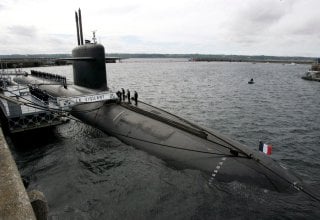Yes, France’s Next Generation Nuclear Missile Submarines Are Already on the Drawing Board
So soon?
France’s nuclear-armed submarines won’t be replaced until the 2030s. But the replacement is already being designed.
Though France’s current nuclear-powered ballistic missile submarines are comparatively new, their replacements are already on the drawing boards. The first of the Triomphant-class, as they are known, entered service with the French Navy in 1997, and the last of the class, in 2010. Once they reach the end of their service lives, sometime in the mid- 2030s, their replacement will jump into the water.
The Triomphant-class replacement, tentatively called SLNE 3G, an acronym meaning sous-marins nucléaires lanceurs d’engins—or nuclear-powered ballistic missile submarine—will incorporate a number of advanced features not seen on the preceding Triomphant-class.
The SLNE 3G is estimated to be longer than the Triomphant-class. This additional length is likely for housing a larger and quieter nuclear reactor, rather than additional missiles. The Triomphant-class has space inside the hull for 16 M45 or M51 nuclear ballistic missiles arranged in two 8-silo groups aft of the sail. The SLNE 3G will probably be equipped with the M51 as well.
Armament
The M51 is relatively new and entered service with the French Navy in 2010. France is the sole M51 operator. The M51 is thought to have similar characteristics as the American and British Trident II missile, though the M51 has a slightly shorter range (about 10,000 kilometers) compared to the Trident II (12,000+ kilometers). Explosive power is roughly comparable, and both missiles are similar in size.
Specs
The SLNE 3G’s nuclear reactor is said to be a derivative of the reactor used on both the upcoming Barracuda-class, and the Charles de Gaulle aircraft carrier. In addition to on-board electronics, the reactor will power the SLNE 3G’s unique propulsion system—a pump-jet.
In contrast to traditional submarine propellers, jet-pups are quieter, though more complex. They feature a nozzle surrounding one or more propellers and are more efficient at nearly all speeds. Essentially they help a submarine to go faster, without an increase in noise.
The UK-based Thales group will develop the SLNE 3G’s sonar. Thales also developed the older Rubis-class’ and the still-in-development Barracuda-class’ sonar. The SLNE 3G will likely have a bow sonar antenna, as well as dual flank arrays and a towed array, allowing the SLNE 3G to “see” in many directions simultaneously.
Like previous nuclear-powered ballistic missile submarines, the SLNE 3G class will like be berthed at the somewhat mysterious Île Longue in Frances’s north west. Île Longue is apparently one of the most heavily defended locations in France and facilitates relatively quick access to the Atlantic and Mediterranean oceans.
Postscript
The Triomphant-class is young—the last hull entered service just 10 years ago. But, as global threats change, the navy has to adapt as well. When commissioned, the SLNE 3G will one of the most advanced sub designs afloat.
Caleb Larson holds a Master of Public Policy degree from the Willy Brandt School of Public Policy. He lives in Berlin and writes on U.S. and Russian foreign and defense policy, German politics, and culture.
Image: Reuters

